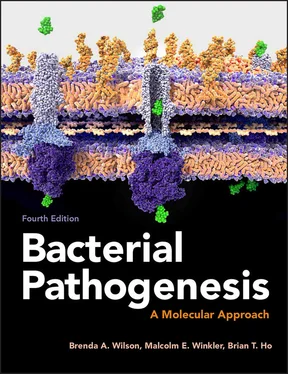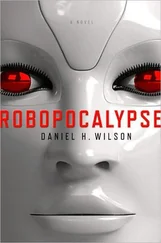In developing countries especially, there is another important eukaryotic component of the colonic microbiota that consists of protozoa and helminths (e.g., tapeworms). We tend to think of protozoa and helminths as pathogens, but this picture may not be entirely correct. Many people who carry these microbes are not sick. In fact, the eukaryotic component of the microbiota has been a fact of human life for millions of years. In areas of the world where such eukaryotic microbes are endemic, a majority of the population maintains them without any adverse effects. Only during the past century, and only in more developed parts of the world, has the eukaryotic component of the microbiota been virtually eliminated due to clean water, better hygiene, and a high-quality food supply.
There is some evidence that the abrupt (in evolutionary terms) loss of the eukaryotic component of the microbiota by people who live in developed countries may have contributed to a number of adverse effects, such as allergies and IBD. One current hypothesis is that helminths, and possibly protozoa as well, stimulate the arm of the immune system that consists of IgE, eosinophils, mast cells, and other cell types that are negatively associated with allergies and IBD. Support for this hypothesis arises from the fact that early stimulation of the gastrointestinal immune system by eukaryotic microbes allows this part of the immune response to develop normally. Conversely, failure to experience this type of stimulation may, in some people, predispose them to disease caused by overstimulation of the inflammatory response. The impact of the loss of these eukaryotic microbes on the bacterial microbiota has not yet been explored thoroughly, but efforts are now moving in this direction.
SELECTED READINGS
Arnold JW, Roach J, Azcarate-Peril MA. 2016. Emerging technologies for gut microbiome research. Trends Microbiol 24:887–901. [PubMed] [CrossRef]
Bäckhed F, Ley RE, Sonnenburg JL, Peterson DA, Gordon JI. 2005. Host-bacterial mutualism in the human intestine. Science 307:1915–1920. [PubMed] [CrossRef]
Caulfield T, Evans J, McGuire A, McCabe C, Bubela T, Cook-Deegan R, Fishman J, Hogarth S, Miller FA, Ravitsky V, Biesecker B, Borry P, Cho MK, Carroll JC, Etchegary H, Joly Y, Kato K, Lee SS, Rothenberg K, Sankar P, Szego MJ, Ossorio P, Pullman D, Rousseau F, Ungar WJ, Wilson B. 2013. Reflections on the cost of “low-cost” whole genome sequencing: framing the health policy debate. PLoS Biol 11:e1001699. [PubMed] [CrossRef]
Chen Y, Zhang W, Knabel SJ. 2005. Multi-virulence-locus sequence typing clarifies epidemiology of recent listeriosis outbreaks in the United States. J Clin Microbiol 43:5291–5294. [PubMed] [CrossRef]
Deleo FR, Chen L, Porcella SF, Martens CA, Kobayashi SD, Porter AR, Chavda KD, Jacobs MR, Mathema B, Olsen RJ, Bonomo RA, Musser JM, Kreiswirth BN. 2014. Molecular dissection of the evolution of carbapenem-resistant multilocus sequence type 258 Klebsiella pneumoniae. Proc Natl Acad Sci USA 111:4988–4993. [PubMed] [CrossRef]
Franzosa EA, Hsu T, Sirota-Madi A, Shafquat A, Abu-Ali G, Morgan XC, Huttenhower C. 2015. Sequencing and beyond: integrating molecular ‘omics’ for microbial community profiling. Nat Rev Microbiol 13:360–372. [PubMed] [CrossRef]
Franzosa EA, Morgan XC, Segata N, Waldron L, Reyes J, Earl AM, Giannoukos G, Boylan MR, Ciulla D, Gevers D, Izard J, Garrett WS, Chan AT, Huttenhower C. 2014. Relating the metatranscriptome and metagenome of the human gut. Proc Natl Acad Sci USA 111:E2329–E2338. [PubMed] [CrossRef]
Gill SR, Pop M, Deboy RT, Eckburg PB, Turnbaugh PJ, Samuel BS, Gordon JI, Relman DA, Fraser-Liggett CM, Nelson KE. 2006. Metagenomic analysis of the human distal gut microbiome. Science 312:1355–1359. [PubMed] [CrossRef]
Greaves J, Roboz J. 2014. Mass Spectrometry for the Novice. CRC Press, Boca Raton, FL.
Holt KE, Baker S, Weill FX, Holmes EC, Kitchen A, Yu J, Sangal V, Brown DJ, Coia JE, Kim DW, Choi SY, Kim SH, da Silveira WD, Pickard DJ, Farrar JJ, Parkhill J, Dougan G, Thomson NR. 2012. Shigella sonnei genome sequencing and phylogenetic analysis indicate recent global dissemination from Europe. Nat Genet 44:1056–1059. [PubMed] [CrossRef]
Huttenhower C, et al, Human Microbiome Project Consortium. 2012. Structure, function and diversity of the healthy human microbiome. Nature 486:207–214. [PubMed] [CrossRef]
Kong HH, Morris A. 2017. The emerging importance and challenges of the human mycobiome. Virulence 19:1–3. [PubMed] [CrossRef]
Ley RE, Peterson DA, Gordon JI. 2006. Ecological and evolutionary forces shaping microbial diversity in the human intestine. Cell 124:837–848. [PubMed] [CrossRef]
Mayer EA, Knight R, Mazmanian SK, Cryan JF, Tillisch K. 2014. Gut microbes and the brain: paradigm shift in neuroscience. J Neurosci 34:15490–15496. [PubMed] [CrossRef]
McClure R, Balasubramanian D, Sun Y, Bobrovskyy M, Sumby P, Genco CA, Vanderpool CK, Tjaden B. 2013. Computational analysis of bacterial RNA-Seq data. Nucleic Acids Res 41:e140. [PubMed] [CrossRef]
McDonald D, Ackermann G, Khailova L, Baird C, Heyland D, Kozar R, Lemieux M, Derenski K, King J, Vis-Kampen C, Knight R, Wischmeyer PE. 2016. Extreme dysbiosis of the microbiome in critical illness. MSphere 1:e00199–e16. [PubMed] [CrossRef]
Nunn KL, Forney LJ. 2016. Unraveling the dynamics of the human vaginal microbiome. Yale J Biol Med 89:331–337. [PubMed]
Parker MT. 2016. An ecological framework of the human virome provides classification of current knowledge and identifies areas of forthcoming discovery. Yale J Biol Med 89:339–351. [PubMed]
Rawls JF, Mahowald MA, Ley RE, Gordon JI. 2006. Reciprocal gut microbiota transplants from zebrafish and mice to germ-free recipients reveal host habitat selection. Cell 127:423–433. [PubMed] [CrossRef]
Reid G, Kim SO, Köhler GA. 2006. Selecting, testing and understanding probiotic microorganisms. FEMS Immunol Med Microbiol 46:149–157. [PubMed] [CrossRef]
Rhoads A, Au KF. 2015. PacBio sequencing and its applications. Genomics Proteomics Bioinformatics 13:278–289. [PubMed] [CrossRef]
Salyers AA, Gupta A, Wang Y. 2004. Human intestinal bacteria as reservoirs for antibiotic resistance genes. Trends Microbiol 12:412–416. [PubMed] [CrossRef]
Samuel BS, Gordon JI. 2006. A humanized gnotobiotic mouse model of host-archaeal-bacterial mutualism. Proc Natl Acad Sci USA 103:10011–10016. [PubMed] [CrossRef]
Stumpf RM, Wilson BA, Rivera A, Yildirim S, Yeoman CJ, Polk JD, White BA, Leigh SR. 2013. The primate vaginal microbiome: comparative context and implications for human health and disease. Am J Phys Anthropol 152(Suppl 57):119–134. [PubMed] [CrossRef]
Ursell LK, Metcalf JL, Parfrey LW, Knight R. 2012. Defining the human microbiome. Nutr Rev 70(Suppl 1):S38–S44. [PubMed] [CrossRef]
Wischmeyer PE, McDonald D, Knight R. 2016. Role of the microbiome, probiotics, and ‘dysbiosis therapy’ in critical illness. Curr Opin Crit Care 22:347–353. [PubMed] [CrossRef]
Yarza P, Yilmaz P, Pruesse E, Glöckner FO, Ludwig W, Schleifer K-H, Whitman WB, Euzéby J, Amann R, Rosselló-Móra R. 2014. Uniting the classification of cultured and uncultured bacteria and archaea using 16S rRNA gene sequences. Nat Rev Microbiol 12:635–645. [PubMed] [CrossRef]
Yeoman CJ, Thomas SM, Miller ME, Ulanov AV, Torralba M, Lucas S, Gillis M, Cregger M, Gomez A, Ho M, Leigh SR, Stumpf R, Creedon DJ, Smith MA, Weisbaum JS, Nelson KE, Wilson BA, White BA. 2013. A multi-omic systems-based approach reveals metabolic markers of bacterial vaginosis and insight into the disease. PLoS One 8:e56111. [PubMed] [CrossRef]
Yildirim S, Yeoman CJ, Janga SC, Thomas SM, Ho M, Leigh SR, White BA, Wilson BA, Stumpf RM, Primate Microbiome Consortium. 2014. Primate vaginal microbiomes exhibit species specificity without universal Lactobacillus dominance. ISME J 8:2431–2444. [PubMed] [CrossRef]
Читать дальше












